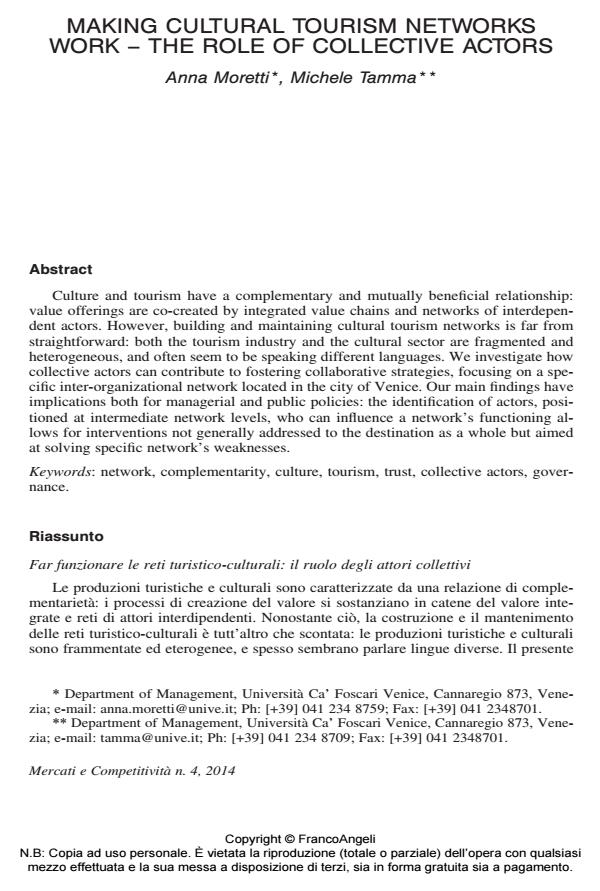Making cultural tourism networks work - the role of collective actors
Journal title MERCATI & COMPETITIVITÀ
Author/s Anna Moretti, Michele Tamma
Publishing Year 2014 Issue 2014/4
Language Italian Pages 21 P. 63-83 File size 189 KB
DOI 10.3280/MC2014-004005
DOI is like a bar code for intellectual property: to have more infomation
click here
Below, you can see the article first page
If you want to buy this article in PDF format, you can do it, following the instructions to buy download credits

FrancoAngeli is member of Publishers International Linking Association, Inc (PILA), a not-for-profit association which run the CrossRef service enabling links to and from online scholarly content.
Culture and tourism have a complementary and mutually beneficial relationship: value offerings are co-created by integrated value chains and networks of interdependent actors. However, building and maintaining cultural tourism networks is far from straightforward: both the tourism industry and the cultural sector are fragmented and heterogeneous, and often seem to be speaking different languages. We investigate how collective actors can contribute to fostering collaborative strategies, focusing on a specific inter-organizational network located in the city of Venice. Our main findings have implications both for managerial and public policies: the identification of actors, positioned at intermediate network levels, who can influence a network’s functioning allows for interventions not generally addressed to the destination as a whole but aimed at solving specific network’s weaknesses.
Le produzioni turistiche e culturali sono caratterizzate da una relazione di complementarietà: i processi di creazione del valore si sostanziano in catene del valore integrate e reti di attori interdipendenti. Nonostante ciò, la costruzione e il mantenimento delle reti turistico-culturali è tutt’altro che scontata: le produzioni turistiche e culturali sono frammentate ed eterogenee, e spesso sembrano parlare lingue diverse. Il presente lavoro di ricerca analizza come gli attori collettivi possano contribuire allo sviluppo di strategie collaborative, e in particolare si focalizza su un caso di rete inter-organizzativa sviluppata nella città di Venezia. I principali risultati di questo lavoro hanno implicazioni sia manageriali che di politiche pubbliche: l’identificazione degli attori, posizionati a livelli intermedi della rete, in grado di influenzarne il funzionamento permette di individuare interventi non diretti alla destinazione nel suo insieme, ma volti a risolvere le specifiche debolezze della rete.
Keywords: Network, complementarity, culture, tourism, trust, collective actors, governance
- The Network Organization Anna Moretti, pp.119 (ISBN:978-3-319-52092-6)
- Ambidexterity of hospitality trade associations: a social capital perspective for destination coordination and cooperation dynamics Anna Moretti, Maria Martini Barzolai, Mariapia Cutugno, in Current Issues in Tourism /2024 pp.1
DOI: 10.1080/13683500.2024.2414929 - The Network Organization Anna Moretti, pp.89 (ISBN:978-3-319-52092-6)
Anna Moretti, Michele Tamma, Making cultural tourism networks work - the role of collective actors in "MERCATI & COMPETITIVITÀ" 4/2014, pp 63-83, DOI: 10.3280/MC2014-004005